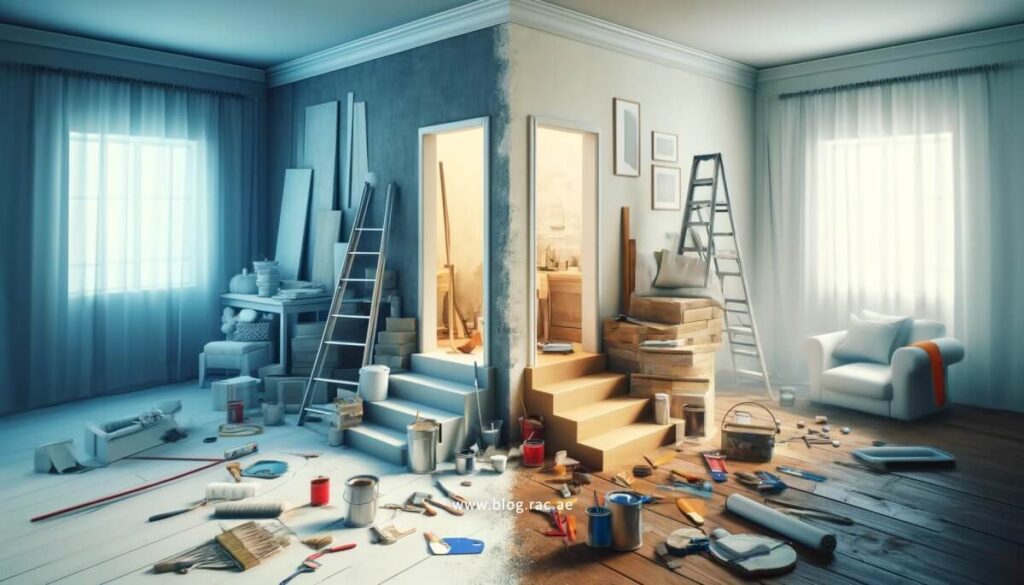
Overcoming Challenges: Unique Solutions for a Complex Project
April 28, 2024
Open Concept Challenge: Creating Flow and Functionality in a Large Space
May 4, 2024Hidden Costs of DIY: When Does It Make More Sense to Hire a Professional?

The DIY trend has captivated many homeowners, inspired by a plethora of online resources that promise significant savings and personal gratification. Yet, the choice between embarking on a DIY project or hiring a professional is nuanced, fraught with hidden complexities and costs that are often overlooked. This article delves into these intricacies to aid homeowners in making informed decisions that align with their capabilities and project demands.
Table of Contents
Understanding DIY: Pros and Cons
Pros:
- Cost Savings: One of the main draws of DIY is the elimination of professional labor costs, potentially leading to substantial financial savings.
- Personal Satisfaction: The completion of a DIY project offers a profound sense of achievement, enhancing one’s connection to their living space.
- Flexibility: DIYers enjoy the freedom to schedule their work and make spontaneous modifications, tailoring the outcome to their exact preferences.

Cons:
- Time Investment: What may initially seem like a quick job can easily expand into a longer, more complex project.
- Risk of Costly Mistakes: Inexperience can lead to errors that are expensive to rectify, possibly exceeding the cost of professional services.
- Underestimating Complexity: Many home improvement tasks are more demanding than they appear, requiring skills and tools beyond the scope of the average homeowner.
When to Consider Hiring a Professional
Pros:
- Expertise and Experience: Professionals bring a wealth of knowledge and proficiency, ensuring the project meets industry standards and regulations.
- Time Efficiency: Due to their expertise, professionals can complete projects quicker than an average DIYer, a crucial factor when time is of the essence.
- Long-term Cost Savings: The initial higher cost of hiring a professional can prevent future expenditures on fixing DIY errors.

Cons:
- Higher Upfront Costs: Professional services can be costly, especially when considering labor and project management fees.
- Scheduling Issues: Relying on professionals might lead to dependency on their availability, which can delay project timelines.
- Less Control: Employing professionals might mean less personal input and direct control over how tasks are executed.
Evaluating the Scope of Your Project
It’s essential to assess the scale and complexity of your project before deciding. Simple tasks like minor repairs or painting might be well-suited to DIY. In contrast, projects requiring specialized knowledge, such as electrical work or major structural changes, should typically be handled by professionals.
Cost Analysis: Hidden Costs of DIY
DIY projects might save on labor costs but don’t forget the expenses associated with purchasing tools, materials, and potentially redoing parts of the project if mistakes occur. These hidden costs can accumulate, negating the perceived savings from not hiring a professional.
Case Studies and Real-Life Examples
Real-world examples of both successful DIY projects and those that necessitated professional intervention illustrate the practical aspects of choosing between DIY and hiring professionals. These narratives underscore the importance of a well-considered decision based on project specifics.
Key Takeaways: Making Informed Choices Between DIY and Professional Help
Deciding between DIY and hiring a professional for home improvement projects involves careful consideration of various factors. Key takeaways include assessing your skills accurately relative to the project’s complexity, understanding the potential hidden costs of DIY projects, and recognizing the benefits professionals bring in terms of expertise, efficiency, and long-term savings. While DIY projects can offer personal satisfaction and cost savings for simpler tasks, complex renovations typically benefit from the expertise and efficiency of professionals. Evaluating the scope of your project, the risks involved, and the value of your time will help ensure that your home improvement efforts are both satisfying and successful.
Conclusion
Choosing between DIY and professional assistance hinges on various factors including cost, time, complexity, and personal expertise. While DIY projects can provide satisfaction and potential savings for straightforward tasks, complex renovations typically benefit from the expertise and efficiency that professionals bring. Carefully weighing these considerations will help ensure that your home improvement efforts are both satisfying and successful, aligning with your overall goals and lifestyle needs.
FAQs
1. What are some hidden costs of DIY projects?
DIY projects can initially appear cheaper since you aren’t paying for professional labor. However, hidden costs include purchasing tools and materials that you may not already have, the potential expenses from correcting mistakes, and the value of the time you invest in the project.
2. Why might DIY projects end up being more complex than anticipated?
Many DIYers underestimate the complexity of home improvement tasks, which often require specific skills and tools. This underestimation can lead to extended project times and the risk of costly errors.
3. What are the benefits of hiring a professional for home improvement projects?
Hiring a professional can bring several advantages, such as expertise in the field, adherence to industry standards, faster project completion, and potential long-term savings from having the job done right the first time.
4. When should I consider hiring a professional instead of DIYing?
You should consider hiring a professional for projects that involve specialized knowledge, like electrical work, plumbing, or structural changes, which go beyond basic home repair and could pose safety risks if not done correctly.
5. Can hiring a professional save money in the long run?
Yes, although the initial cost of hiring a professional is higher, it can prevent future expenses related to fixing mistakes made during a DIY project. Professionals ensure that the work is completed correctly, reducing the likelihood of future issues.
6. What should I consider when evaluating the scope of a project?
Assess the project’s scale and complexity, your own skills and resources, the potential risks involved, and whether the outcome will align with your desired standard of quality and safety.
7. How does personal satisfaction play into the decision to DIY?
DIY projects offer a profound sense of personal satisfaction and achievement from creating or improving something yourself. This emotional benefit is a significant factor for many homeowners when deciding to undertake a project on their own.
8. What are the disadvantages of relying on professionals for home renovations?
While professionals bring expertise and efficiency, their services can be costly, and you might face scheduling issues due to their availability. Additionally, you might have less control over the exact execution of your project.
9. How can DIY projects affect my living space?
DIY projects can temporarily disrupt your living space, creating mess and disorganization. The duration and extent of this disruption can vary greatly depending on the nature of the project.
10. What are some real-life examples of DIY vs. professional project outcomes?
The article references real-world examples where DIY projects were successful as well as instances where professional intervention was necessary. These stories highlight the importance of accurately assessing one’s abilities and the project requirements before beginning work.
11. What is scope creep and how does it impact DIY projects?
Scope creep refers to the uncontrolled expansion of a project’s scope without corresponding adjustments to resources, budget, or timeline. It impacts DIY projects by causing delays, increasing costs, and often leading to incomplete or substandard results.
12. How does time investment differ between DIY and professional projects?
DIY projects often require a significant time investment from the homeowner, which can be challenging to manage alongside other responsibilities. Professionals, on the other hand, can complete projects more quickly due to their expertise and dedicated time.
13. What risks are associated with DIY home improvement?
Risks associated with DIY home improvement include the potential for making costly mistakes, injury from using unfamiliar tools, and not meeting safety or building codes, which can lead to further expenses and legal issues.
14. How do you balance cost savings with quality in DIY projects?
Balancing cost savings with quality in DIY projects involves careful planning, investing in good quality materials and tools, and being realistic about your skills. Sometimes, spending a bit more initially can save money and time in the long run by avoiding costly mistakes.
15. What are some signs that a project is too complex for DIY?
Signs that a project is too complex for DIY include requirements for specialized skills or knowledge (such as electrical or plumbing work), the need for specific permits or adherence to building codes, and the potential for significant structural impact or safety hazards.


0 Comments
Hello, Neat post. There’s a problem along with your website in web explorer, might check this?K IE still is the market chief and a big part of other people will leave out your wonderful writing due to this problem.